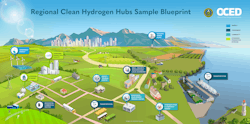Hydrogen Hubs: Driving the Move to Fuel Cells in Heavy-Duty Trucks
What you'll learn:
- What are the goals of the H2Hubs?
- Factors essential in the selection of H2Hub regions.
- Locations selected for the H2Hub projects.
The U.S. Department of Energy (DOE) announced that $7 billion will be appropriated to launch seven Regional Clean Hydrogen Hubs (H2Hubs) across the nation. The backing is part of an effort to accelerate the commercial-scale deployment of low-cost hydrogen that can be produced with zero or near-zero carbon emissions.
The H2Hubs are expected to collectively produce three million metric tons of hydrogen annually, reaching nearly a third of the 2030 U.S. production target. It’s also anticipated that they will help lower emissions from hard-to-decarbonize industrial sectors that represent 30% of total U.S. carbon emissions.
Together, these hubs will also reduce 25 million metric tons of carbon-dioxide (CO2) emissions from end-uses each year—an amount roughly equivalent to the combined annual emissions of 5.5 million gasoline-powered cars.
Clean hydrogen is a flexible energy carrier that can be produced from a diverse mix of domestic clean energy resources, including renewables, nuclear, and fossil resources with safe carbon capture. It can also be used as a form of long-duration energy storage to support the expansion of renewable power.
Driving Forces Behind H2Hub Selection
Key areas the DOE evaluated when selecting H2Hubs included:
- Technical Merit and Impact—including but not limited to the ability of the proposed hub to deploy infrastructure and produce at least 50 to 100 metric tons of clean hydrogen per day and reduce greenhouse gas emissions.
- Financial and Market Viability—including growth potential and market competitiveness of the proposed hub.
- Workplan—including the speed at which the hub could begin operations and overall project-management details.
- Management Team and Project Partners—including the team’s ability to execute the plan with a high level of success.
- Community Benefits Plan—including an assessment of community and labor engagement, quality job creation and workforce development, diversity equity inclusion, and accessibility.
Selection for award negotiations is not a commitment by the DOE to issue an award or provide funding. Before funding is issued, the DOE and the applicants will undergo a negotiation process, and the DOE may cancel negotiations and rescind the selection for any reason during that time.
Projects chosen for negotiation include:
Appalachian Hydrogen Hub (Appalachian Regional Clean Hydrogen Hub (ARCH2); West Virginia, Ohio, Pennsylvania)
The Appalachian Hydrogen Hub will leverage the region’s ample access to low-cost natural gas to produce low-cost clean hydrogen and permanently store the associated carbon emissions. The strategic location of this H2Hub and the development of hydrogen pipelines, multiple hydrogen fueling stations, and permanent CO2 storage also have the potential to drive down the cost of hydrogen distribution and storage.
California Hydrogen Hub (Alliance for Renewable Clean Hydrogen Energy Systems (ARCHES); California)
The California Hydrogen Hub is expected to produce hydrogen exclusively from renewable energy and biomass. It will provide a blueprint for decarbonizing public transportation, heavy-duty trucking, and port operations—key emissions drivers in the state and sources of air pollution that are among the hardest to decarbonize.
Gulf Coast Hydrogen Hub (HyVelocity H2Hub; Texas)
The Gulf Coast Hydrogen Hub will be centered in the Houston region. It will help kick start the clean hydrogen economy with its plans for large-scale hydrogen production using both natural gas with carbon capture and renewables-powered electrolysis. The hub will leverage the Gulf Coast region’s abundant renewable energy and natural gas supply to drive down the cost of hydrogen—a crucial step to achieving market lift-off.
Heartland Hydrogen Hub (Minnesota, North Dakota, South Dakota)
The Heartland Hydrogen Hub will leverage the region’s energy resources to help decarbonize the agricultural sector’s production of fertilizer, decrease the regional cost of clean hydrogen, and advance the use of clean hydrogen in electric generation and for cold climate space heating.
It also plans to offer unique opportunities of equity ownership to tribal communities through an equity partnership as well as to local farmers and farmer co-ops. A private sector partnership will allow local farmers to receive more competitive pricing for clean fertilizer.
Mid-Atlantic Hydrogen Hub (Mid-Atlantic Clean Hydrogen Hub (MACH2); Pennsylvania, Delaware, New Jersey)
The Mid-Atlantic Hydrogen Hub will help unlock hydrogen-driven decarbonization in the Mid-Atlantic while repurposing historic oil infrastructure and using existing rights-of-way. It plans to develop renewable hydrogen production facilities from renewable and nuclear electricity using both established and innovative electrolyzer technologies, where it can help reduce costs and drive further technology adoption.
Midwest Hydrogen Hub (Midwest Alliance for Clean Hydrogen (MachH2); Illinois, Indiana, Michigan)
The Midwest Hydrogen Hub will enable decarbonization through strategic hydrogen uses including steel and glass production, power generation, refining, heavy-duty transportation, and sustainable aviation fuel. This H2Hub plans to produce hydrogen by leveraging diverse and abundant energy sources, including renewable energy, natural gas, and low-cost nuclear energy.
Pacific Northwest Hydrogen Hub (PNW H2; Washington, Oregon, Montana)
The Pacific Northwest Hydrogen Hub plans to leverage the region’s renewable resources to produce clean hydrogen exclusively via electrolysis. Its anticipated widescale use of electrolyzers will play a key role in driving down electrolyzer costs, making the technology more accessible to other producers. It will also help reduce the cost of hydrogen production.
DOE’s Office of Clean Energy Demonstrations (OCED) manages the H2Hubs program and will provide project management oversight for the projects selected to produce clean hydrogen.

